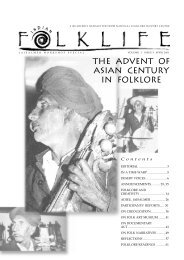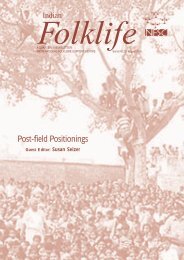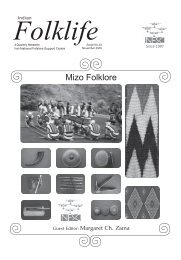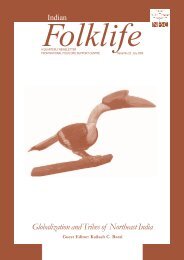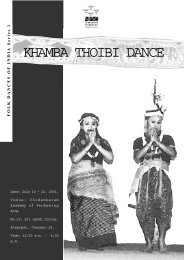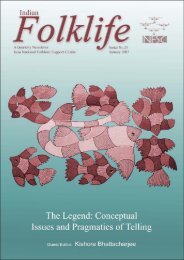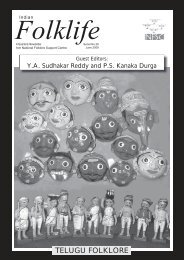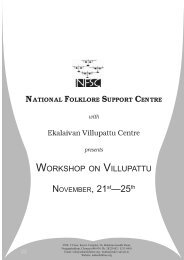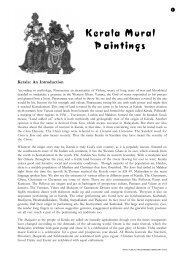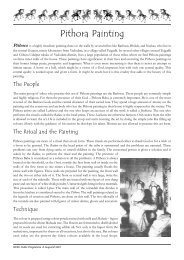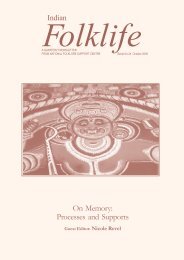Bamboo Flowering in the North-East - Wiki - National Folklore ...
Bamboo Flowering in the North-East - Wiki - National Folklore ...
Bamboo Flowering in the North-East - Wiki - National Folklore ...
Create successful ePaper yourself
Turn your PDF publications into a flip-book with our unique Google optimized e-Paper software.
Internal metaphors like“humans are trees” organiseknowledge - <strong>in</strong>clud<strong>in</strong>g folkclassifications- but <strong>the</strong>y alsoproduce o<strong>the</strong>r figures thatdelimit semantic fields: thusvegetal metaphors concernrites of passage, and animalmetaphors stress <strong>the</strong>difficulty of gett<strong>in</strong>g mature.Analys<strong>in</strong>g Santal twistedspeech, we have noted <strong>the</strong>centrality and recurrence ofsome of <strong>the</strong>se tropes - <strong>the</strong>bone and <strong>the</strong> flesh stand<strong>in</strong>gfor <strong>the</strong> permanent andephemeral - as if m<strong>in</strong>orgenres were contribut<strong>in</strong>g toA Santali drummershape analogical knowledge.The same analogy of bones and gra<strong>in</strong>s produces andorganises metaphors at different levels of discourse.Internal metaphors show how different parts of <strong>the</strong> treebecome equivalent to different parts of <strong>the</strong> human body.External metaphors show how <strong>the</strong> transformation of fleshand bone is a common central paradigm for animals andhumans. The recurrence of <strong>the</strong>se metaphors means <strong>the</strong>yare embodied <strong>in</strong> ritual, as we have seen from <strong>the</strong> sequenceof funerals, where <strong>the</strong> mourner makes flower out of bone,a symbol of regeneration of <strong>the</strong> l<strong>in</strong>eage.Courtesy: www.kamat.orgKnowledge of metaphors varies greatly between persons:for common people, riddles and jokes are easier toremember than stories about ancestors or narrativesconcern<strong>in</strong>g <strong>the</strong> bongas, which may relate to <strong>in</strong>dividualexperiences and are not evoked publicly. Common peoplememorise <strong>the</strong> “little talk” <strong>the</strong>y have to remember on ritualoccasions like name-giv<strong>in</strong>g and marriage but thisknowledge is limited if we compare it to <strong>the</strong> ojha’s oratoryart. The ojha tries to enhance any ritual he performs bydisplay<strong>in</strong>g two k<strong>in</strong>ds of knowledge. The first k<strong>in</strong>d ofknowledge is characterised by stories concern<strong>in</strong>g <strong>the</strong>ancestors and is shared with senior men. His secondknowledge <strong>in</strong>cludes change <strong>in</strong> tradition (Carr<strong>in</strong> 1986) s<strong>in</strong>ceojhas are more or less H<strong>in</strong>duised and share a broader fluxof knowledge which takes its roots, <strong>in</strong> Bengal, <strong>in</strong> popularas well as sect H<strong>in</strong>duism, evok<strong>in</strong>g Bal<strong>in</strong>ese moral andritual system of thoughts. (Barth 2002).seduce are drawn to use sweet words, to resist <strong>the</strong> sarcasmof good orators. It is important to be able to decodemetaphors to guess at <strong>the</strong> hidden <strong>in</strong>tentions ofprotagonists of discourse, as men, bongas, witches or evenojhas usually lie. But how can one avoid ly<strong>in</strong>g <strong>in</strong> achang<strong>in</strong>g world where <strong>the</strong> basic criteria of truth arechang<strong>in</strong>g? And how are metaphors able to <strong>in</strong>form Santalsof <strong>the</strong> process of knowledge production and change <strong>in</strong>tradition? Most Santals understand <strong>the</strong>se figures whileojhas monopolise some sectors of knowledge such asritual discourse and knowledge of <strong>the</strong> pharmacopia.The conceptual structure of <strong>the</strong> ojha’s knowledge isdifferent, s<strong>in</strong>ce he is used to confront<strong>in</strong>g <strong>the</strong> knowledgeof his colleagues who may belong to differenttraditions. The systematic nature of <strong>the</strong> ojha’sknowledge reflects his ability to unite a heterogeneousset of skills and beliefs <strong>in</strong>to a coherent discourse. Themetaphors that <strong>the</strong> ojha uses help him to conflate <strong>the</strong>diversity of his <strong>in</strong>spiration <strong>in</strong>to a model that he cantransmit to his disciples. In oppos<strong>in</strong>g <strong>the</strong> knowledgeof <strong>the</strong> common man to that of <strong>the</strong> ojha, I have tried toshow how several branches of knowledge coexist,stress<strong>in</strong>g that <strong>the</strong> metaphorical base of both susta<strong>in</strong> atacit communication between Santals. But <strong>the</strong> ojha’smetaphors seem superfluous to ord<strong>in</strong>ary people, s<strong>in</strong>ce<strong>the</strong>y do not l<strong>in</strong>k <strong>in</strong>to everyday knowledge and ritualdiscourse, which for <strong>the</strong>m shape both <strong>the</strong> worlds <strong>the</strong>yperceive and <strong>the</strong> image of <strong>the</strong> world that <strong>the</strong>y cast <strong>in</strong>torituals.But metaphors also stress <strong>the</strong> importance of tacitcommunication <strong>in</strong> a society where secrecy andwitchcraft are central. Among Santals, to tell <strong>the</strong> truthrequires div<strong>in</strong>ation as if it was difficult for ord<strong>in</strong>arypeople to guess what <strong>the</strong>ir addressee really wants tohear. Metaphors must fit <strong>the</strong> audience. How to speaktruth and be a good orator when <strong>the</strong> audience hasbecome heterogeneous, some shar<strong>in</strong>g <strong>the</strong> values of <strong>the</strong>irH<strong>in</strong>du neighbours while o<strong>the</strong>rs are steeped <strong>in</strong> tribalrevivalist ideas? Those who cannot impose <strong>the</strong>ir speechlack prestige, while those who want to conv<strong>in</strong>ce orCourtesy: www.kamat.orgA Santali girl with her pet10 INDIAN FOLKLIFE VOLUME 2 ISSUE 3 JANUARY - MARCH 2003



